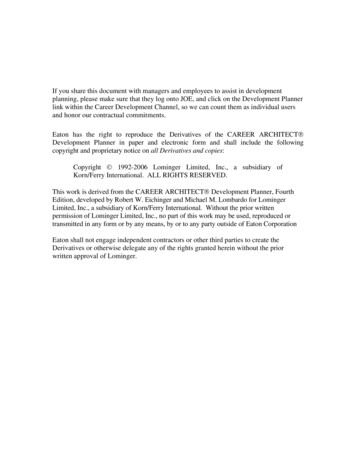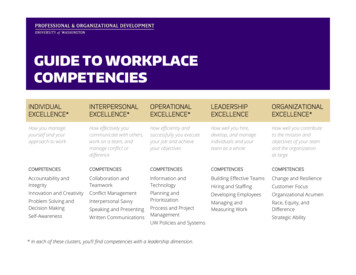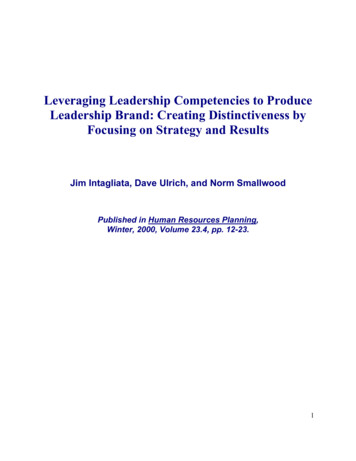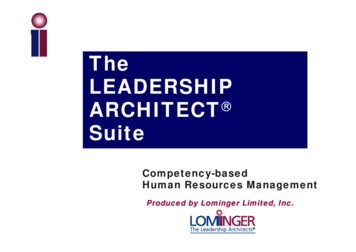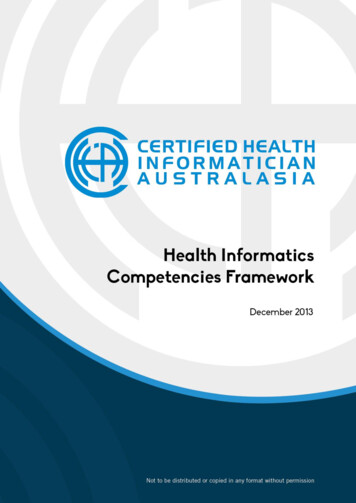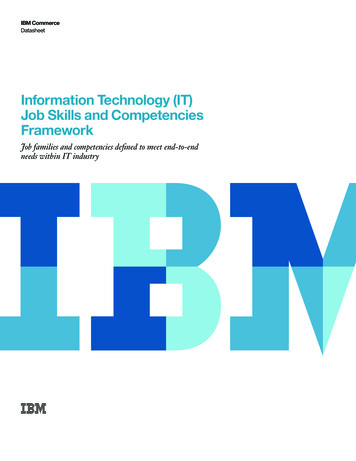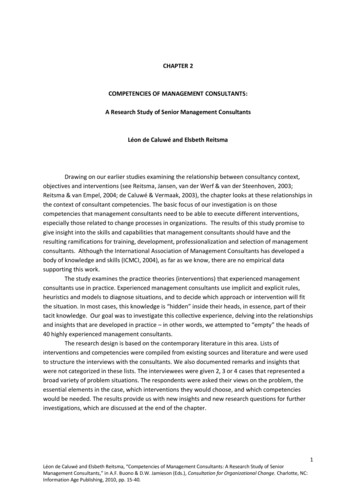
Transcription
CHAPTER 2COMPETENCIES OF MANAGEMENT CONSULTANTS:A Research Study of Senior Management ConsultantsLéon de Caluwé and Elsbeth ReitsmaDrawing on our earlier studies examining the relationship between consultancy context,objectives and interventions (see Reitsma, Jansen, van der Werf & van der Steenhoven, 2003;Reitsma & van Empel, 2004; de Caluwé & Vermaak, 2003), the chapter looks at these relationships inthe context of consultant competencies. The basic focus of our investigation is on thosecompetencies that management consultants need to be able to execute different interventions,especially those related to change processes in organizations. The results of this study promise togive insight into the skills and capabilities that management consultants should have and theresulting ramifications for training, development, professionalization and selection of managementconsultants. Although the International Association of Management Consultants has developed abody of knowledge and skills (ICMCI, 2004), as far as we know, there are no empirical datasupporting this work.The study examines the practice theories (interventions) that experienced managementconsultants use in practice. Experienced management consultants use implicit and explicit rules,heuristics and models to diagnose situations, and to decide which approach or intervention will fitthe situation. In most cases, this knowledge is “hidden” inside their heads, in essence, part of theirtacit knowledge. Our goal was to investigate this collective experience, delving into the relationshipsand insights that are developed in practice – in other words, we attempted to “empty” the heads of40 highly experienced management consultants.The research design is based on the contemporary literature in this area. Lists ofinterventions and competencies were compiled from existing sources and literature and were usedto structure the interviews with the consultants. We also documented remarks and insights thatwere not categorized in these lists. The interviewees were given 2, 3 or 4 cases that represented abroad variety of problem situations. The respondents were asked their views on the problem, theessential elements in the case, which interventions they would choose, and which competencieswould be needed. The results provide us with new insights and new research questions for furtherinvestigations, which are discussed at the end of the chapter.1Léon de Caluwé and Elsbeth Reitsma, “Competencies of Management Consultants: A Research Study of SeniorManagement Consultants,” in A.F. Buono & D.W. Jamieson (Eds.), Consultation for Organizational Change. Charlotte, NC:Information Age Publishing, 2010, pp. 15-40.
RESEARCH MODEL AND THEORETICAL FRAMEWORKA goal of this study as to make explicit the relations between: 1) the context in which thechange took place; 2) the general approach that was applied; 3) the interventions that were chosen;and the competencies that the consultant needed to undertake the intervention. The researchmodel that guided this work is captured in Figure oundStyle of changeBasic competenciesOwn repertoireFig 2-1 Research Model: Competencies of Management Consultants in Change ProcessesThe rationale for this choice is as follows. A change takes place in a specific situation – thecontext (i.e., the combination of objectives of the change and characteristics of the situation). Onthe basis of this context, the consultant decides on an approach and related interventions. To beable to execute these interventions, a consultant needs certain competencies. Some of thesecompetencies are intervention specific (i.e., they are coupled to the intervention) and some arebasic competencies (i.e., they are always needed, independent of the context or specificintervention). The approach that a consultant chooses, the interventions that he or she utilizes andthe required competencies are related to background characteristics of the consultant. As anexample, one can think of the type of training that the consultant followed. The same holds true forthe personal style of change that the consultant embraces and the repertoire of interventions andcompetencies that the consultant thinks he or she has mastered (i.e., their own repertoire).Operationalization of ContextWe define context as the situation in which the consultants does interventions or in whichthe change take place. Thinking about context has its roots in Lawrence and Lorsch’s (1967)contingency thinking. The essence of this approach is that the best way to organize is specified bythe situation. The “right” way to intervene in organizations is derived from (a cluster of) variablesthat play a dominant role in the situation. We assume that two main variables play a significant rolein establishing the context: 1) the objectives of the change; and 2) the characteristics of the situationin which the change will take place (see, for example, de Caluwé & Vermaak, 2003).Objectives of the changeThere are several theories that categorize the objectives or content of change. We havechosen 4 types of objectives: 1) strategy and structure; 2) products, services and processes; 3)2Léon de Caluwé and Elsbeth Reitsma, “Competencies of Management Consultants: A Research Study of SeniorManagement Consultants,” in A.F. Buono & D.W. Jamieson (Eds.), Consultation for Organizational Change. Charlotte, NC:Information Age Publishing, 2010, pp. 15-40.
culture, interaction and leadership; and 4) knowledge, skills and attitudes (e.g., Cummings & Worley,2005; de Caluwé & Vermaak 2003, 2004). We wanted to build in a variety of objectives in theresearch; therefore we constructed four cases in which this variety of objectives was reflected.Context variablesThe literature has a range of variables that are suggested to influence the choice of a specificintervention. For the purpose of the present study, we searched for a theory that was viewed asrather complete, with assumptions on the relationships between the variables, but without anoverwhelming number of variables. We selected Otto’s (2000) framework with eight variables, inwhich each of these variables has a certain value and the variables are related. Otto also provides“rules of thumb” about the connection of the variables and the degree in which certain changestrategies are possible (or impossible). The value of each of these variables (and especially theconfiguration of these variables, combined with the objectives of the change) influences the choiceof an intervention. This theory and its eight variables were used as the framework for our research(see Table 2-1). We wanted to explore whether there was empirical evidence for the relationshipsbetween the objectives, these context variables and the choice for intervention.Context VariablesVariable Meaning 1. Time pressureWhat is the deadline that something must be solved? Is it close to thedeadline already? Time pressure can be great or absent, but there can alsobe no time to work on the problem because all the energy goes to dailyoperations.Is there tension between parties? How intense is it? Are parties capable ofcollective reflection?Does one party have possibilities to influence the behavior of others? Isthere a power center or equilibrium between centers? Is approval needed byone of the power centers? Can someone make the decision?Are the persons involved in their work strongly dependent upon each other?Can they work independently?Are there rules and procedures for decision making? Are the authoritiesclearly described?Does one identify with the organization? Do many people act as spectators?2. Escalation3. Power differences4. Dependencies5. Rules6. Identification withthe organization7. Capabilities forreflection8. Knowledge andskillsIs there opportunity for reflection? Is it present or absent? High or low?Does one have all the knowledge and skills to cope with the problem? Isoutside expertise needed?Table 2-1 Context Variables and Their MeaningFour cases were constructed in which the variables in Table X-1 were systematicallyincorporated. These four cases create the context for the study. Each of the interviewees was askedto respond to these cases, focusing on their assessment of: the problem, its essential elements,3Léon de Caluwé and Elsbeth Reitsma, “Competencies of Management Consultants: A Research Study of SeniorManagement Consultants,” in A.F. Buono & D.W. Jamieson (Eds.), Consultation for Organizational Change. Charlotte, NC:Information Age Publishing, 2010, pp. 15-40.
which intervention(s) they would choose, and which competencies would be necessary. Table 2-2provides an example of one of these four cases.A consultancy firm has experienced poor financial results. Inside the company there is aninvestigation as to what the causes might be. This investigation is carried out among the seniorconsultants through intensive talks.From these conversations it becomes evident that the strategy of the firm is obsolete and that theinternal structure does not fit with the developments in the market. The senior consultants arguethat the firm needs to reconsider its strategy and adapt its internal structure.Financial results, however, go down further. Management is faced with a fast decision, because thefirm will not survive if the situation continues. There is a lot of unrest within the organization andmany of the consultants do not have enough work. Most of them feel very involved in the firm anddo not leave. But the situation is precarious. People start looking at each other: do you spendenough time on client acquisition and marketing? Are you doing too much internal work? Are welooking enough to the outside world?The various groups engage in self assessments, focusing on what they can do to confront thesituation. They analyze the market and their conversations focus on what each person can do toclear up this situation. Most of the people are experts in the area of strategic assessment and in thearea of the target groups they typically work for.The discussions are very interesting and valuable. But they do not result in a new strategy orstructure. The management does not know how to cope with this problem and is consideringturning to external help.Objective: Strategy and structureContext variables: Time pressure: YesEscalation: HighPower differences: SmallDependency: LowIdentification with the organization: HighCapability for reflection: HighKnowledge and skills: ExtensiveTable 2-2 Example of a Case: Variables in ContextOperationalization of Consultancy ApproachesWe define approach as generic coping with the (problem) situation. There are severalcategorizations of these approaches in the literature. Each one has different assumptions aboutchange, different ways of steering the change process, and different actors that are involved (seeTable 2-3). The study makes a clear distinction between two approaches: design of change and4Léon de Caluwé and Elsbeth Reitsma, “Competencies of Management Consultants: A Research Study of SeniorManagement Consultants,” in A.F. Buono & D.W. Jamieson (Eds.), Consultation for Organizational Change. Charlotte, NC:Information Age Publishing, 2010, pp. 15-40.
development of change. The first is a planned process with a lot of influence from the changemanager and experts, without much attention to interaction and participation. The second is a moreevolving and emerging process, with a lot of actors who can exert influence and a high degree ofattention to interaction and participation.AUTHORBoonstra & Vink(2004)Beer & Nohria(2000)Weick & Quinn(1999)Huy (2001)Chin & Benne(1970)De Caluwé &Vermaak (2003)APPROACHESDevelopDesignTheory ETheory OEpisodic/Planned changeContinuous/Emergent intRedprintSocializingNormative re-educativeGreenprintWhiteprintTable 2-3 Scheme of Change ApproachesExamining the different categories of interventions, we discovered that for all interventionsone could choose both of these approaches. For instance, one could undertake a strategyintervention as the expert, in a small group, on the drawing table. But one could also approach thesame challenge through a participative process, in a large group setting, as an emergent process. Werefer to this as a generic approach.Our study uses this dichotomy in the degree of participation on a ten point scale, rangingfrom the expert approach (i.e., expert judgment or proposal, small group) to a more processoriented approach (i.e., participative, involving large numbers of employees (see Figure 2-2).Expert approachProcess approachOne or small group1 --------------------------------------- 10ParticipativeJudgment or proposalInvolvement of employeesby expertFigure 2-2 Operationalization of the General ApproachOperationalization of InterventionsWe define interventions as one or a series of intended change activities aimed at improvingthe functioning of the organization (Cummings & Worley, 2005; de Caluwé & Vermaak, 2003, 2004).While interventions can be aimed at the individual, group or organizational level, the studyemphasized the group and organization level.The literature on this subject is abundant and we were inspired by several authors (Boonstra, 2004;Cummings & Worley, 2005; Keuning, 2007; Kubr, 2000; Schein, 1969, 1999). Based on this work,Table 2-4 presents a categorization of these interventions, capturing the relevant authors and their5Léon de Caluwé and Elsbeth Reitsma, “Competencies of Management Consultants: A Research Study of SeniorManagement Consultants,” in A.F. Buono & D.W. Jamieson (Eds.), Consultation for Organizational Change. Charlotte, NC:Information Age Publishing, 2010, pp. 15-40.
main thoughts related to this categorization. Table 2-5 lists the interventions, definitions andexamples that were used in the study.Interventionsfocused on:Orientation andawarenessCummings &WorleyStrategic questionsand images of thefutureAdaptation of thestructure or waysof cooperationStrategicprogramsImprovement ofbusinessperformance andbusiness processesMotivation ofemployees (withHRM instruments)TechnostructuralGovernance andcontrolTraining anddevelopmentProcesses (social)between peopleScheinKubrKeuningOrganizationaldiagnosis andproblem solvingtechniquesBoonstraLearning andresearch larrangementsCompaign type,action-orientedchangeprogramsCompaign esign rective tasksHuman processCoaching andcounselingHuman processAgenda raining esContinuouslearning andchanging by meansof interactionLeadership andcultureGroup dynamicsInquiring,dialogue andnarrative;Learning andresearch inactionTable 2-4 Categories of Interventions6Léon de Caluwé and Elsbeth Reitsma, “Competencies of Management Consultants: A Research Study of SeniorManagement Consultants,” in A.F. Buono & D.W. Jamieson (Eds.), Consultation for Organizational Change. Charlotte, NC:Information Age Publishing, 2010, pp. 15-40.
Interventions focused on:Orientation and awareness:The acknowledgement of thenature and cause of a problemand the awareness of the needfor change.Strategic questions and imagesof the future:The formation of images of thefuture of the organization andsharing of the images.Adaptation of a structure or wayof cooperation:The making of provisions andcircumstances, fitted to makechanges possible.Improvement of businessperformance and businessprocesses:Changing the business processesin order to improve results.Motivation of employees withHRM instruments:Enhancing the motivation ofworkers to improve the flexibilityor the achievements of theorganization.Description of the intervention and examplesSWOT analysis: mapping the strengths, weaknesses, opportunities andthreats of the own achievements and that of the competitors and to knowthe developments in the environment and to decide upon the strategy.Benchmarking: comparing own achievements with those of the bestcompetitors to see on which parts the organization can improve.Balanced Score Card: mapping or measuring indicators for performance onfinance, business processes, innovation and customers to see on which partsthe organization performs according the expectations.Causal loop diagrams: mapping cause-effect relations to see repetitions andpatterns. The diagrams show which factors can be influenced easily or onlyin a very complicated way.Other examples: Porter’s model; Environment scan.Strategic change plan: making of a plan with objectives and means to realizea desired long term positioning of the organization in its environment,starting from where we are now.Search conference: using a conference method (large scale intervention) tocreate a well considered desired and reachable future.Strategic culture change: developing a strong and shared collective culturethat is different of what we have now, but is important for the continuationof the organizationProject organization: a person, group or entity that executes a clear definedassignment within the organization.Temporary groups: task forces that have clear defined tasks (developing newideas; making priorities).Pilot project: experimenting on a small scale with one or some changes.New organization entities: the creation of one or more new parts of theorganization for example to offer new servicesAdaptation of the structure: the clarification and adaptation of the divisionof tasks, responsibilities and mechanisms for coordination.Outsourcing: placing activities that were executed within the organizationoutside.Other examples: mergers, joint ventures, reorganizationsBusiness process redesign: a (large) shift or change in the working processes.Total quality: a permanent process to raise customer satisfaction bysystematic work on the improvement of products or services.The conference model: using a conference method to reconsider workingprocesses and to improve the relations with customers, following thestrategy of the organizationRewarding system: a system to improve the performance and satisfaction ofemployees and to decrease undesired behaviour by rules for rewards andpromotion.Selection: placing the right man or woman on the right place.Career development: supporting people in their careers in the organizationand the formulation of career goals.Task enlargement: expand parts of tasks on the same level.7Léon de Caluwé and Elsbeth Reitsma, “Competencies of Management Consultants: A Research Study of SeniorManagement Consultants,” in A.F. Buono & D.W. Jamieson (Eds.), Consultation for Organizational Change. Charlotte, NC:Information Age Publishing, 2010, pp. 15-40.
Interventions focused on:Governance and control:Developing insight in theprogress, quantity and quality ofthe work.Training and development:Learning of new thoughts,concepts, skills or insights.Processes (social)betweenpeople:Improving social processes inorganizations – interpersonalrelations, functioning of a team,the relations between teamsContinuous learning andchanging by means ofinteraction:Keeping up the process ofinteraction and communication.Description of the intervention and examplesTask enrichment: expand parts of tasks with higher level work and moreroom for decision making.Control: see to it that the work is done properly.Report: making and giving reports on the performance or progress ofactivities for a certain period.Time sheets: reporting on how much time is spent on activities.Training: learning of skills by managers or employees.Workshops: making people sensible for the need to change, for trends, fordifferent options or for certain methods or concepts.Feedback: letting individuals, groups or the organization see what the effectis of their behavior or performance on others.Coaching or counseling: giving individuals feedback to improve the personaleffectiveness, to create more self confidence and to provide them withknowledge and skills.Gaming/simulations: experiencing through gaming what consequences oreffects one’s own behavior has.Survey feedback: gathering information and knowledge in an active processabout problems and solutions and then execute activities based on thatinformationOther examples: 360 degrees feedbackProcess consultation/teambuilding: helping a group to analyze its ownfunctioning, to find solutions for dysfunctional group processes.Search conference: an organization wide meeting in order to find importantvalues and to develop new ways to solve problems.Process management: facilitating decision making in complex situations.Third party: an independent third party helps the interaction and problemsolving between parties.Other examples: T-groups; Organization confrontation meeting; intergrouprelations; agenda setting.Action learning: creating a context in which one can learn with others.Essential is the exchange of experiences and collective reflection.Action research: creating cooperation between researchers and other actorsto do research and to learn together.Dialogue: creating various ideas about reality, sharing them and constructingnew realities on the basis of interaction.Narratives/ story telling: creating and finding stories, looking for differentviews and contradictions, reading between the lines and so creating newstories.Table 2-5 Interventions, Descriptions and Examples Per InterventionOperationalization of CompetenciesSimilar to Hoekstra and Van Sluijs (2003), we define competence as something that someoneis good at. Although this definition appears simple, there is a lot of discussion and confusion aboutthe concept. Does competence refer to skill, expertise, attitude, capabilities or knowledge?Competences have to do with generic characteristics of a person, with skills and attitude. The8Léon de Caluwé and Elsbeth Reitsma, “Competencies of Management Consultants: A Research Study of SeniorManagement Consultants,” in A.F. Buono & D.W. Jamieson (Eds.), Consultation for Organizational Change. Charlotte, NC:Information Age Publishing, 2010, pp. 15-40.
concept is not clear in detail, but we wanted to use this language to be able to communicate withour interviewees about the essential capabilities of a consultant. We collected several theoreticalnotions and lists of competencies from the literature and compiled them into a list of competenciesthat might be important in the execution of a change process. This list is a taxonomy that is based onthe domains and competencies proposed by Hoekstra and Van Sluijs (2003), Yukl, Fable and Youn(1993, 2002), and Volz and de Vrey (2000). We have also used many of their definitions. The list usedin the present study is presented in Table 2-6.DomainEnterprisingCompetencies1. Boldness2. Individuality3. Independence4. Entrepreneurship5. Market orientedShowingresilience6. Adaptability7. Flexibility8. Stress tolerance9. RestraintOrganizing10. Monitoring progress11. Planning12. Organizing ability13. Making coalitionsPerforming14. Result orientation15. Attention to details16. Persistence17. Quality orientation18. EnergyDescriptionTaking certain risks in order to gain expected long-termbenefits.Seeking opportunities and taking action to exploit them.Acting on one’s own initiative rather than passively awaitingevents.Acting on the basis of one’s convictions rather than on adesire to please others. Steering one’s own course.Identifying business opportunities and undertaking action,including calculated risks, to take advantage of them.Being well informed about developments in the market andtechnology. Using this information effectively in actions.Acting appropriately by expedient adaptation to changingenvironments, tasks or responsibilities and to differentpeople.Changing one’s style or approach when new opportunitiesrequire such a change.Performing steadily and effectively under time pressure,regardless of setbacks, disappointments or opposition.Reacting calmly and in proportion to the significance of theissue at hand.Being able to adequately control one’s emotions and reacteffectively to those of others, even in emotionally taxingsituations. Avoiding undesirable commitments andescalations.Effectively monitoring progress in one’s work and that ofothers, given the available time and resources, anticipatingfuture developments and taken appropriate timely measures.Determining objectives and priorities effectively, planningtimely measures in order to attain stated goals.Identifying and recruiting people and other resources in orderto carry out a plan; allocating them in such a way that theintended results are achieved.Seeking and using support, help and sponsors to convince aperson or a group.Focusing one’s actions and decisions on intended results andgiving priority to the realization of stated objectives.Paying attention to detail; being able to focus on and dealwith detailed information in a sustained way.Sticking to a chosen approach or position until the intendedresults have been achievedSetting high demands with respect to the quality of one’s ownwork and that of others, striving continuously forimprovements.Being able to be extremely active for long periods when9Léon de Caluwé and Elsbeth Reitsma, “Competencies of Management Consultants: A Research Study of SeniorManagement Consultants,” in A.F. Buono & D.W. Jamieson (Eds.), Consultation for Organizational Change. Charlotte, NC:Information Age Publishing, 2010, pp. 15-40.
DomainCompetencies19. Ambition20. Legitimating21. Problem solvingAnalyzing22. Analytical skills23. Conceptual thinking24. Learning orientation25. CreativityConsidering26. Balanced judgment27. Awareness of theexternal environment28. Generating vision29. Innovating30. Awareness oforganizational contextFacilitating31. Customer orientation32. Coaching33. Co-operation34. Listening35. Sensitivity36. Accuracy37. InspiringDescriptionnecessary. Working hard; having stamina.Demonstrating an aspiration to be successful in one’s career;investing in personal development in order to achieve this.Showing the legitimacy of a request by the authority orclaiming the right to do the request or showing that therequest is in accordance with the policy, the rules or traditionsin an organization.Signalizing of (potential) problems and solving these one selfor with others.Breaking a problem down into its component parts; describingits source and structure. Seeking possible causes andgathering relevant data.Providing wider or deeper understanding of situations orproblems by applying another frame of reference or byconnecting them with other information.Showing an interest in new information, taking in new ideasand developments and applying them effectively.Suggesting original solutions for problems related to one’swork; devising new ways of doing things.Comparing possible courses of action and assessing availableinformation, applying relevant criteria. Making realisticjudgments and decisions based on such assessments.Keeping well informed about societal and politicaldevelopments and relevant issues in the environment; usingthis knowledge to the advantage of the organization.Identifying the main direction for the organization in relationto its environment; formulating long-term objectives andstrategies.Creating new and original ideas, ways of working andapplications by combining formal and informal information,existing and new solutions and approaches.Demonstrating an understanding of how things work in anorganization, taking the consequences for one’s ownorganization and that of the customer into account in one’saction.Enquiring about the needs and wishes of customers andclients and showing that one’s thinking and actions reflectthem.Supporting others in the execution of their work. Motivatingothers and making them think about improving their ownbehavior. Being a partner for talking and listening.Contributing actively to achieving a common aim, even whenthis is not in one’s personal interest; fostering helpfulcommunication.Picking up important signals and messages in oralcommunication and giving space to others to expressthemselves, paying attention to their reactions, respondingappropriately and, where necessary, asking further questions.Showing that you recognize feelings, attitude and motivationof others and be open for it. Understanding one’s owninfluence on others and taking that into account.Acting careful and punctual, aimed at the anticipation offailures. Detailed execution of activities.Creating enthusiasm for a request or proposal by evoking10Léon de Caluwé and Elsbeth Reitsma, “Competencies of Management Consultants: A Research Study of SeniorManagement Consultants,” in A.F. Buono & D.W. Jamieson (Eds.), Consultation for Organizational Change. Charlotte, NC:Information Age Publishing, 2010, pp. 15-40.
DomainCompetencies38. Awareness of costs39. Personal appealInfluencing40. Communication41. Presentation42. Persuasion43. SociabilityManaging44. Decisiveness45. Leadership46. Delegation47. Communicating vision48. Consultation49. Negotiating skills50. Diplomatic51. Awareness of risk52. NetworkingIntegrity53. Integrity54. Reliability55. LoyaltyDescriptionvalues, ideals and aspirations of a group or person or showingthat a person or group has the qualities to do a task or achievea goal.Taking into account returns and costs in short and long term.Recognize costs.Making a personal appeal upon the loyalty or sympathy of aperson or group.Communicating ideas and information clearly and correctly sothat the essential message comes across and is fullyunderstood.Presenting oneself in such a way that the first impression ispositive, turning such an impression into lasting respect orsympathy.Presenting ideas, points of view or plans convincingly toothers so tha
COMPETENCIES OF MANAGEMENT CONSULTANTS: A Research Study of Senior Management Consultants Léon de Caluwé and Elsbeth Reitsma Drawing on our earlier studies examining the relationship between consultancy context, objectives and interventions (see Reit
